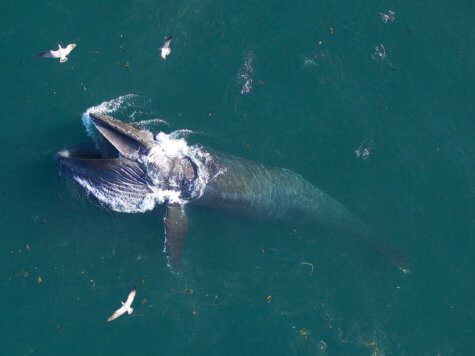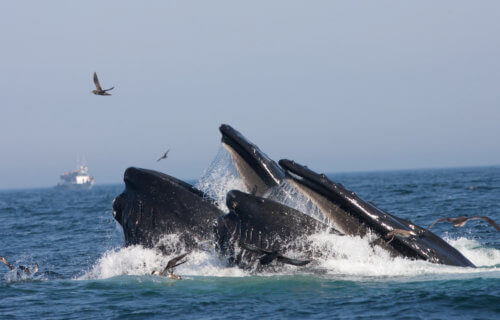
WASHINGTON — Baleen whales, which include the blue, fin, and humpback whales, eat more food than anyone ever suspected, according to a new study. Researchers say the giant mammals consume two million tons of fish, krill, zooplankton, and squid each year.
These whales are the largest animals that ever lived. Scientists say they suck up tinier organisms by filtering seawater through plates of frayed, bristle-like combs in its huge jaws. The new findings show that baleen whales eat three times more food than previously believed.
A blue whale can reach up to 110 feet in length and weigh over 200 tons; eating almost a third of its body mass every single day! Moreover, researchers believe the vast amounts of poop they produce is helping to save the planet by reducing global warming emissions. The discovery could boost conservation efforts which are saving the endangered behemoths.
“Our results say that if we restore whale populations to pre-whaling levels seen at the beginning of the 20th century, we’ll restore a huge amount of lost function to ocean ecosystems,” says co-author Dr. Nicholas Pyenson, curator of fossil marine mammals at the Smithsonian’s National Museum of Natural History, in a media release.
“It may take a few decades to see the benefit, but it’s the clearest read yet about the massive role of large whales on our planet.”

Whales are key to the underwater ecosystem
Before the whaling era, estimates show whales consumed about 430 million tons of krill annually in the Southern Ocean near Antarctica. That’s substantially greater than today’s entire world fish catch. Intense fishing has since decimated ocean stocks. Whale feeding seems to be sustainable, as evidenced by their long lifespan and high degree of specialization geared to just one main food source — krill.
Study authors tagged 321 baleen whales from seven species in the Atlantic, Pacific, and Southern oceans — tracking daily foraging behavior and prey consumption. The team found that whales consume a daily average of between five and 30 percent of their body mass. For example, populations of blue, fin, and humpback whales in the California Current Ecosystem each require more than two million tons of krill every year.
This means the undersea giants are vital to ocean health and productivity as they also pump out more waste. It keeps key nutrients suspended close to the surface where they power blooms of carbon-absorbing phytoplankton — the basis of their food-web.
Without whales, those nutrients more readily sink to the seafloor, limiting the capacity of ocean ecosystems to absorb greenhouse gases.
Tagging whales provides new insights into ocean life
Lead author Dr. Matthew Savoca, a marine ecologist at Stanford University, likens the team’s tags suction-cupped to the whales’ backs to a miniature smartphone.
Each whale was fitted with a camera, microphone, GPS, and an accelerometer to monitor movements in three-dimensional space. The data set also included drone photographs of 105 whales to measure their respective lengths.
Knowing each animal’s length helped to create accurate estimates of its body mass and the volume of water the mammals filter with each mouthful. Finally, members of the team involved in this near-decade-long data collection effort used small boats equipped with echo-sounders to race to sites where whales feed.
The echo-sounders use sound waves to detect and measure the size and density of swarms of krill and other prey species. This step was crucial empirical grounding for the team’s estimates of just how much food the whales might be consuming.
Scientists combined three lines of evidence: how often whales feed, how much prey they can potentially consume while feeding, and how much prey is available where they eat. With that information, the team could generate the most accurate estimates to date of how much these gargantuan mammals eat each day and, by extension, each year.
How much are different whales eating?
For example, the study found an adult eastern North Pacific blue whale likely consumes 16 metric tons of krill per day during its foraging season. A North Atlantic right whale eats about five metric tons of small zooplankton daily. A bowhead whale puts down roughly six metric tons of small zooplankton per day.
When more whales enter a region to chow down on krill, that generally means there’s a lot more krill around for them to eat. The decline of numbers following the loss of so many of their biggest predators is known as “the krill paradox.”
It is most pronounced in areas where whaling has been especially intense, such as the Scotia Sea between the Southern and Atlantic Oceans southeast of South America.
“This decline makes no sense until you consider that whales are acting as mobile krill processing plants,” Dr. Savoca explains.
“These are animals the size of a Boeing 737, eating and pooping far from land in a system that is iron-limited in many places. These whales were seeding productivity out in the open Southern Ocean and there was very little to recycle this fertilizer once whales were gone.”
Restoring the pre-whaling ecosystem
The study, published in the journal Nature, suggests restoring whale populations could also boost the amount of carbon dioxide sucked up by the phytoplankton — which krill eat.
Estimates show the nutrient cycling services provided by pre-whaling populations at the start of the 20th century might fuel a roughly 11 percent increase in marine productivity in the Southern Ocean. This would also draw down at least 215 million metric tons of carbon, absorbed and stored in ocean ecosystems and organisms in the process of rebuilding.
Indeed, the findings suggest in the Southern Ocean, for example, baleen whales recycled 12,000 tons of iron per year before whaling, compared to 1,200 tons per year today.
“Our results suggest the contribution of whales to global productivity and carbon removal was probably on par with the forest ecosystems of entire continents, in terms of scale,” Dr. Pyenson concludes. “That system is still there, and helping whales recover could restore lost ecosystem functioning and provide a natural climate solution.”
South West News Service writer Mark Waghorn contributed to this report.
